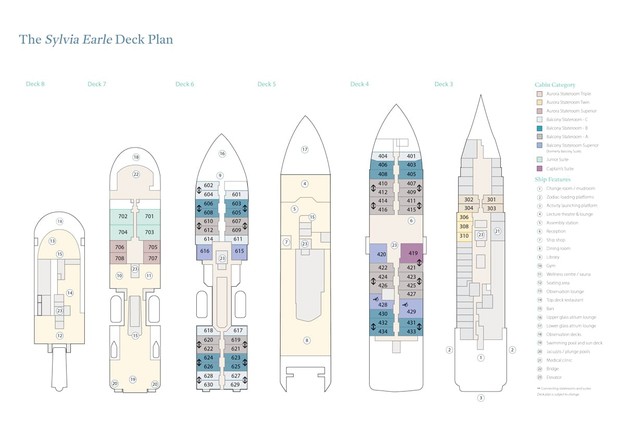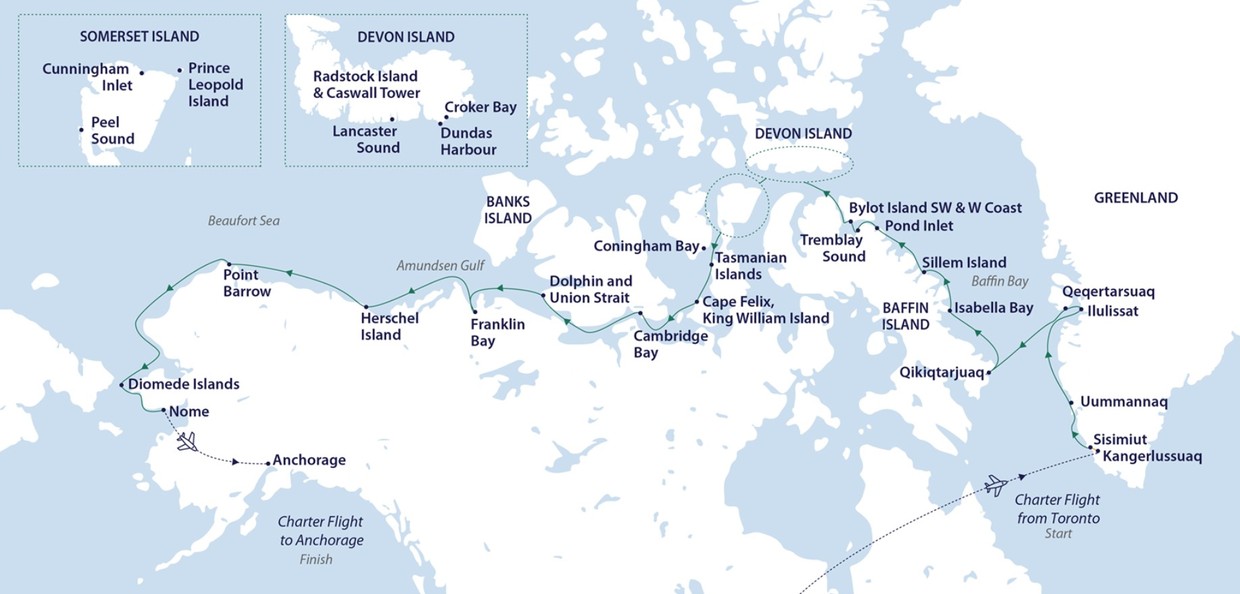
On this epic voyage inspired by Roald Amundsen’s historic expedition, we attempt to sail the full length of the Northwest Passage, carving our way west through the labyrinthine maze of waterways that hug the fabled islands of Arctic Canada until we reach the Beaufort Sea. Building on our classic Northwest Passage voyage, we visit historical sites explored by heroic explorers, meet the incredible folk that call this region home, and search for enigmatic wildlife found in this unique corner of the world. Pack ice may halt our voyage through the passage, so brace yourself for a genuine expedition where adventure awaits at every turn.
- Stand in awe of Ilulissat Icefjord, a UNESCO World Heritage Site
- Hike on Devon Island, the world’s largest uninhabited island, which features stunning geology, fjords and glacial valleys to explore
- On Beechey Island, visit memorials and graves of explorers from John Franklin’s expedition
- Keep watch with the hope of spotting iconic Arctic wildlife including musk ox, polar bears, beluga whales, walrus and perhaps narwhal
There are no future departures for this trip at this stage.
Sylvia Earle
.jpg)
| Cabins | 62 |
|---|---|
| Launched | 2022 |
Sylvia Earle made her inaugural cruise in 2022; she honours the highly accomplished marine biologist, oceanographer and explorer, Sylvia Earle. As the first female chief scientist of the U.S. National Oceanic and Atmospheric Administration, and named by Time Magazine as its first Hero for the Planet in 1998 – this vessel pays tribute to Sylvia’s long standing conservation efforts for marine protected areas and ocean wildlife. Sylvia Earle will be actively involved in the development of her namesake.
The streamlined Ulstein X-BOW® cuts through the swell so you feel fewer vibrations and disturbances, and makes quicker transits through waves. It also helps reduce fuel consumption by up to 60%^. Experience the Glass Atrium Lounge inside the bow, featuring huge windows and superb views to the front of the ship.
In between landings, enjoy the heated saltwater open air swimming pool and jacuzzis on board the Sylvia Earle and watch the world go by, or experience our gym, sauna or enjoy a massage (additional cost) in the Wellness centre.
Sylvia Earle carries many Zodiacs, which you can board via four dedicated, sea-level launching platforms. These platforms make boarding the Zodiacs as quick, efficient and safe as possible, minimising wait times and getting you closer to the action for longer.
Dining
One of the most important parts of any expedition is the food! Whatever adventures the day holds, you will be fuelled-up with hearty meals and delicious morning/afternoon teas cooked by our onboard chefs. Meals are a great time to soak up the expedition camaraderie in our open seating dining area. Share stories with your fellow travellers and ask our expedition team questions that may have come up during the day. Tea, coffee and snacks are available 24 hours a day, and our chefs offer different menu options and courses for each meal. Enjoy the range of house wine, beers and soft drinks included with dinner after a long day in the wild. We also invite you to join your captain and expedition team for informal Captain’s Welcome and Farewell drinks, with complimentary beverages and cocktail appetisers, followed by a 3 course meal.
Responsible Travel
We believe that preserving and protecting the environment is of the utmost importance and this is reflected in several features of the Sylvia Earle. The Sylvia Earle will boast one of the lowest polluting marine engines in the world due to low energy consumption, high fuel-efficiency and a streamlined design to deliver an 80% reduction in emissions.* The ship can also utilise virtual anchoring to hold its position using a combination of GPS, steering technology, propellers and thrusters. This protects the sea floor and minimises the damage caused by conventional anchors.
*Compared to Tier 1 engines.



.jpg)